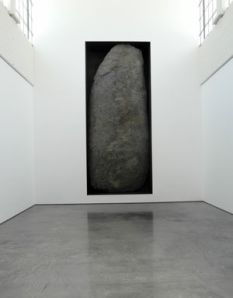A Vast Indoor Space, Dia: Beacon
Dia: Beacon, Exterior shot from http://www.diaart.org/sites/main/beacon
During spring break, Samuel and I trudged through Dia: Beacon, located off Route 9D approximately 60 miles north of Manhattan. Housed in what once was a Nabisco box-printing factory built in 1929, the museum boasts 240,000 square feet of massive indoor space. Natural lighting show cases visitors to a diverse collection of works of art assembled during the 1970’s and early 1980’s by artists such as John Chamberlain, Donald Judd, Sol Le Witt, Richard Serra, Michael Heizer.
![]() Richard Serra, Union of the Torus and the Sphere, 2001. © Richard Serra/Artists
Richard Serra, Union of the Torus and the Sphere, 2001. © Richard Serra/Artists
Rights Society (ARS), New York. Photo: Richard Barnes.
Samuel swaggered with confidence as we opened the steel door to this vast interior. He led the way through each gallery, walking with purpose as if in search of something magical. We made our way to John Chamberlain’s installations of voluminous crushed metal. Samuel surveyed these massive robotic sculptures with special interest. When asked what he saw, he named the dominant colors of each structure. He weaved through these installations with ease. He slowly inched away from this site and expertly maneuvered himself without touching the artwork through a small space that housed one of Richard Serra’s monumental installations. Samuel barely noted the elegance of this robust curved steel that served as a gateway to the next gallery.
Soon we discovered our place among Robert Smithson’s, “Gravel Mirrors with Cracks and Dust,” 1968. Samuel sat quietly on my lap while we examined ourselves on the mirror that was part of the backdrop of these artworks. I pointed out the different objects that were assembled before us, the triangular shapes of the gravel placed carefully on top of some cracked mirror pieces, etc. He ignored my lectures, and instead has fixed his eyes firmly upon our reflections. No words were exchanged. Yet amidst this silence was an acknowledgement of each other’s presence. A game of imitation had emerged. When I smiled, he smirked. When I stretched my arms up-right he raised his. When I covered my face, he took my hands and lifted my hands onto his visage. As we made faces and performed physical gestures in front of the mirror, we too had become part of the art installation.
After quickly navigating through other gallery spaces, Samuel urged me to sit on a bench with him that faced Michael Heizer’s Negative Megalith #5 (1998). I started to ask Samuel what he was looking at. He ignored my question, and just as I was about to query him again, a set of twins, who were about three years old, walked noisily and animatedly into the gallery. One showed his teeth when he smiled and stated aloud, “Oh look at that big stone. I wonder what would happen if it fell down!?” His twin remarked with a dark excitement in his voice, “Of course, it would strike you, because it’s so big.” Their parents rushed them quickly into another gallery as both giggled and gestured comically to one another. As I heard these children narrate the stories in their heads, my heart sank. Words provided others a glimpse of our thought processes. I realized at that moment that I would continue to struggle with this feeling of being shut out from Samuel’s musings for as an eight year-old with Down Syndrome, he used his words only sparingly.
Instead of speaking, we rested quietly in front of this piece of work for 10 minutes. Samuel handed me and saved himself a copy of the fact pages for this piece. He pretended to read the laminated text and after 5 minutes, he collected mine and placed both his and my copy back into its container. I marveled at the comfort with which Samuel carried himself, of being in such a grand exhibition space that we have only visited for the first time! I sat and reveled at this remarkable moment that informed me that my son understands the museum-going experience. This was a triumph!
The experience of walking through a museum and imbibing the philosophical ideas embedded in each object has shifted. I watched Samuel model a unique perspective and noted how he interacted with works of art. My goal would be to continue to build upon these kinds of museum visits so that Samuel can collect a visual vocabulary that will enhance his skills in finding meaning and connections with the world around him. The best kind of learning happens when we are given the opportunity to explore freely and this vast indoor space has certainly provided that for Samuel.
For more information, please visit:
http://www.diaart.org/sites/main/beacon



There is a certain poetry in less words. The blog is wonderful Luella.
Thank you, Linda! I was riding the subway the other day and read one of the poems sponsored by the MTA – Arts for Transit initiative and I was amazed at the imagery and the meaning it evoked in less than 35 words. Whenever Samuel speaks from now on I will consider it poetry and will cherish every line with gratitude. Love, Luella